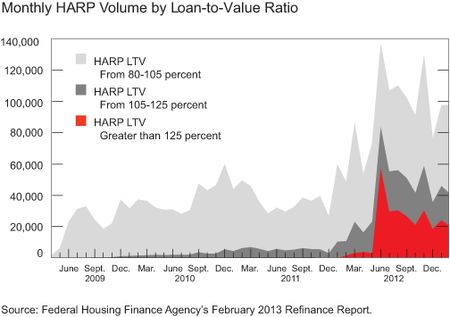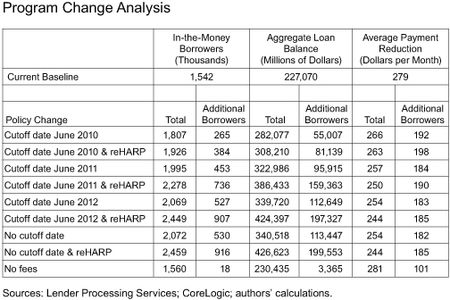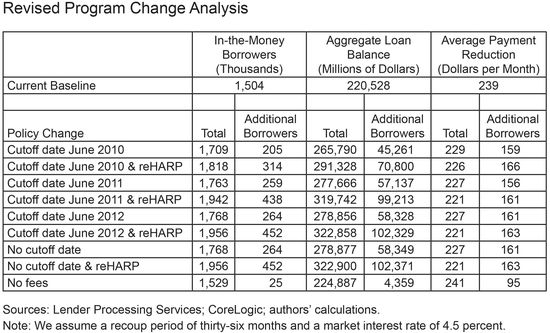Joshua Abel and Joseph Tracy
Since the onset of the housing crisis, a focus of policymakers has been to help underwater homeowners lower their monthly mortgage payments by refinancing, principally through the Home Affordable Refinance Program (HARP). This enables households to commit more money to consumption, debt reduction, and saving. Lower monthly payments also decrease the risk of mortgage defaults, allowing homeowners to stay in their homes and reducing expected losses for mortgage guarantors Fannie Mae and Freddie Mac, which remain under conservatorship of the Federal Housing Finance Agency. Stanching the flow of defaults also helps to firm up the housing market and, therefore, the economy as a whole. In this post, we examine some simple adjustments to HARP that would help to continue the program’s recent success and provide additional support to the housing market recovery—an undertaking that has added significance with the recent increase in mortgage rates, which could hamper refinancing activity moving forward.
Recent home price appreciation has benefited homeowners in most parts of the country. However, millions of homeowners still find themselves with little or no equity in their homes, the result of the earlier steep decline in home prices. Without sufficient equity, it can be very difficult to refinance, which means that these homeowners cannot take advantage of the current low interest rate environment.
HARP is designed to allow borrowers who are current on their payments and whose existing mortgages are guaranteed by Fannie Mae or Freddie Mac to refinance even if their loan-to-value (LTV) ratios are above the 80 percent level that is typically required for prime mortgages. Since HARP’s inception in April 2009, about 2.5 million homeowners have used the program. Much of this success has come since a 2012 redesign (the so-called HARP 2.0). Among other things, this redesign removed the 125 percent LTV limit on HARP refinances, opening the program to borrowers more deeply underwater. The chart below showing a sharp uptick in participation in 2012 makes clear how important that policy change was.
It could be time to consider further program changes. Currently, HARP can only be utilized by borrowers whose mortgages were obtained by Fannie Mae or Freddie Mac by June 1, 2009. Additionally, borrowers are only allowed to use HARP once, meaning that borrowers who have already done so are now ineligible. We find that altering these rules could heighten refinancing activity substantially. To evaluate the potential benefit from relaxing these two program restrictions, we take a random sample of loans and select those that are eligible (backed by Fannie Mae or Freddie Mac, current on payments, and other criteria). We then say that a loan is in-the-money to use HARP if refinancing would decrease the monthly payment enough so that the borrower can recoup the costs of refinancing, such as the appraisal cost and program fees, within three years. We repeat this exercise using different eligibility rules, such as moving the cutoff date from June 1, 2009, and allowing “reHARPing” (refinancing a second time under HARP).
The table below summarizes our results as of February. We estimate that about 1.5 million borrowers are eligible and in-the-money for HARP under current guidelines. Shifting the cutoff date—to 2010, 2011, 2012, and then removing it entirely— adds substantially to this number, though at a decreasing rate. Our analysis shows that eliminating the cutoff date entirely would add 530,000 in-the-money borrowers, an increase of over 30 percent. If reHARPing were also allowed, this increase would climb to over 55 percent.
Note that on the whole, the reduction in monthly payments for these additional borrowers would be lower than for those that are currently eligible, due to the fact that mortgage rates have declined substantially since 2009, meaning their contract rates are already somewhat lower. However, an extra $200 per month could make a significant difference for many individual homeowners and for the macroeconomy, when aggregated. Although heightened refinancing activity will lower returns for investors in agency mortgage-backed securities, the macro effects of additional money in homeowners’ pockets more than offset those losses, meaning that refinancing is not simply a zero-sum transfer from investors to borrowers, as discussed in an earlier post.
Furthermore, there is reason to believe that these program changes could provide a bigger boost than our numbers imply. Consider that the table above provides estimates of how many borrowers have incentive to refinance, not how many will actually do so. Predicting the “take-up” rate—the fraction of in-the-money borrowers who will actually complete a HARP refinance—is a difficult exercise. However, it seems reasonable to believe that the take-up rate among newly eligible borrowers (if, say, the cutoff date was moved) will be a lot higher than for those who are already eligible, but have so far decided not to participate despite the financial incentive to do so. There are various reasons why someone may not participate: lack of information about the program, lack of financial sophistication, or plans to move from the house in the near-term, among others. All of these are unobservable in the data, but eligible borrowers, by not responding to the incentive up to this point, have revealed that some or all of these effects may be at work. Others have not used HARP simply because they have not been allowed, and it is likely that many will rush to do so when given the chance. In fact, there’s evidence for this in our first chart: borrowers with LTV ratios greater than 125 percent became newly eligible in 2012, with a tremendous influx of these borrowers into the program soon after.
The recent improvement in the housing market is welcome news, but it has not erased the negative equity problem brought on by the housing bust. One of the consequences is that many borrowers are still trapped paying interest rates far above the current market rate. HARP is a sensible response to this problem for borrowers with agency mortgages, and changes to the HARP program in 2012 increased the effectiveness of the program. Some additional changes to that program could build on the recent success of HARP and provide ongoing support for the housing market recovery.
Addendum
(July 18, 2013)
The above analysis assumed that a borrower could refinance into a thirty-year fixed-rate mortgage with a rate of 4.0 percent. After receiving reader comments, we have updated the table assuming that a borrower now could refinance into a mortgage rate of 4.5 percent. This 50 basis point increase in the mortgage rate reduces the impacts associated with each proposed program change. For example, removing the origination date deadline would now add an estimated 264,000 additional in-the-money borrowers, a 50 percent reduction from the earlier 530,000. For those borrowers who remain in-the-money, the higher assumed mortgage rate also reduces the extent to which a HARP refinance will lower their monthly mortgage payment. Again, looking at the case of removing the origination date deadline, the reduction in the average monthly payment is an estimated $161, a 12 percent decline from the earlier $182.
Disclaimer
The views expressed in this post are those of the authors and do not necessarily reflect the position of the Federal Reserve Bank of New York or the Federal Reserve System. Any errors or omissions are the responsibility of the authors.
 Joshua Abel is a former research associate in the Research and Statistics Group of the Federal Reserve Bank of New York.
Joshua Abel is a former research associate in the Research and Statistics Group of the Federal Reserve Bank of New York.
 Joseph Tracy is an executive vice president and senior advisor to the Bank president at the Federal Reserve Bank of New York.
Joseph Tracy is an executive vice president and senior advisor to the Bank president at the Federal Reserve Bank of New York.













 RSS Feed
RSS Feed Follow Liberty Street Economics
Follow Liberty Street Economics
Thank you for your comments. The addendum above updates the table using a higher interest rate. See “Revised Program Change Analysis.”
thank you,very useful information
I assume that the table you show is based on Feb 2013 primary mortgage rates. The primary rate is now at least a full percentage point higher than it was back in February. As such, the incremental benefit of expanding HARP eligibility would be much lower now. Do you guys have an updated table? Thanks.
What mortgage rate are you assuming?